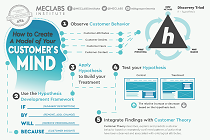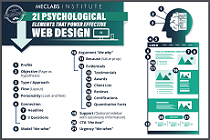
|
SUMMARY:
In this chart article, we show you which strategies most interest your peers. Our article’s never-before-published data shows marketing outpaces advertising in popularity – revealing critical strategic insights. Explore exclusive, state-by-state search data from DesignRush. |
Action Box: How to take a conversion marketing approach to Agentic AI and RAG
Join our masterclass and transform your strategy with AI insights. Register before the event and attend on February 12th at 2 pm EST for exclusive content – a free 10-pack of avatars to use in your AI agent (from MarketingSherpa’s parent organization, MeclabsAI).
The team at DesignRush analyzed a set of keywords it selected as a proxy of overall demand for services used to promote a business in 2024, and then put those keywords into overall categories.
You can scroll below this article to see the full methodology but first let’s look at the data – which has been provided exclusively to MarketingSherpa and has never been published before. Understanding these trends allows you to stay ahead in your market strategy.
Chart: Search analysis of business services

These seven categories were picked because the research team believes they are the most relevant and widely searched for by businesses. They reflect the core services businesses need to grow online. Initially, there were 10 categories based on DesignRush’s top 10 categories from its agency directory, but only seven category keywords (category + ‘near me’) had volumes high enough to be caught by Google Keyword Planner for analyzsis.
Other categories, like app development or social media management, were excluded as they were either too niche or already covered within broader categories like ‘marketing’ or ‘web development.’
What first drew my attention from this data was the popularity of marketing versus advertising. I think this speaks to the transformation of the past several decades in how businesses promote their products and services.
I started in this industry by majoring in advertising in the ‘90s. And when I began my career, a large part of most companies’ promotional strategies was driven by media buys – in print newspapers and magazines or on broadcast TV.
Today, the strategies businesses can use to promote their products and services are vast and growing. They include advertising, but the options certainly don’t stop there – from content marketing to SEO to AI-driven agents.
“What’s surprising is how advertising – a traditional powerhouse – has not kept pace in the digital space,” said Gianluca Ferruggia, General Manager, DesignRush.
You’ll notice that digital marketing is further down this list. My hypothesis is that today many businesspeople just assume digital when searching for marketing, since digital has become so prominent.
“Our primary focus is on marketing, particularly digital marketing,” said Joshua Schirard, director of law enforcement & private security, Byrna, who wasn’t involved with the research.
Schirard’s ideal customers are law enforcement and security professionals. “Traditional advertising doesn't always cut it in this space. Officers, military personnel, and security teams aren't casually scrolling through ads looking for solutions – they're searching for tools that keep them safe and effective in the field,” he said.
So like many companies over the past couple of decades, the team’s approach is not centered on promotional advertising, but rather content marketing. “We don't just market products – we educate. We create content that explains what Byrna is and how it integrates into real-world scenarios. We highlight firsthand testimonials, real training footage, and detailed breakdowns of why a less-lethal approach makes sense for agencies today,” Schirard explained.
‘Web design’ focuses on how a website looks and feels, while ‘web development’ focuses on building the website’s functionality.
Web development is the other promotional activity that topped this chart. Back in the day, if you wanted a longer-form way to promote your product, you would produce a brochure which necessitated graphic design help.
Today, of course, that longer-form product and service communication happens on a website (and is moving to custom AIs, perhaps?).
Agile, high-quality web development allows companies to respond quickly and aggressivley when they identify opportunities. Like this example with a regional Ohio retailer.
"The retailer initially assumed that younger adults would be the primary audience for their products. However, the data showed that middle-aged parents were actually more likely to convert, particularly when targeted with ads showcasing practical solutions for their families. Additionally, by segmenting customers based on purchase behavior (frequent shoppers versus occasional shoppers), they found that the occasional shoppers were more responsive to promotions and discounts, which led to the development of tailored campaigns aimed at re-engaging this group," said Mohammed Kamal, Business Development Manager, Olavivo.
Without web development, these discoveries are just curiosities. But with dynamic content segmentation and tailored landing pages, discoveries like this become moneymakers.
These results are just a snapshot in time. How will they change over the next year, five years, or ten years? These are important strategic questions for any business service company.
For example, AI is helping businesses create smarter websites with better user experiences, which could increase the demand for web development. Or will it decrease the demand because businesses will just use artificial intelligence to create websites directly without the need for a vendor or skilled internal talent?
In SEO, automation tools are making it easier to analyze keywords, optimize content, and improve search rankings faster than ever, which could decrease demand for services and hires. But then again, businesses are losing traffic to AI overviews on search engine results pages and have no need to visit the website, and it may take human providers to help fight back.
“Because of the rise of AI and LLMs, I'm analyzing competitors' page structure and content to determine what gaps my client's pages may have that we need to fill based on an analysis of what AI overviews and/or why LLMs choose to list certain pages/businesses,” said J. Ivy Boyter of Full Throttle SEO, an SEO agency founder who was not involved in the research.
Emerging and ever-changing technology means that many of the services discussed in the data will need to evolve, and a team of human advisers can help you navigate these changes.
For instance, search engine optimization may change from an intense focus on getting people to your webpages from a search engine, to also influencing the AI overview on the SERP. “Marking up FAQs (even though Google says they don't use them) or product details with schema increases the likelihood that those pieces will appear in AI Overviews or SERP snippets,” Boyter said.
As AI-generated search results take over, businesses that don’t adapt their SEO strategies risk becoming invisible.
While the national data tells one story, the real surprises come when we zoom into state-level trends. Colorado leads in digital marketing interest – suggesting a strong local ecosystem for agencies. Meanwhile, states like West Virginia show low engagement, signaling untapped opportunities. Let’s take a closer look.
The DesignRush team also looked at the popularity of these business services for each US state. They normalized the data to average monthly searches per 100,000 population, so big and small states were on a level playing field. For example, Pennsylvania and North Carolina were top performers in the raw data but didn’t stay as high after normalization, which helped highlight smaller states with higher digital activity per resident (you can see the full table with all the data by scrolling down below this article).
This info could be especially helpful for local businesses. Across most states, ‘near me’ was the dominant search phrase, showing that people are actively looking for local service providers. Let’s first see which states led the way for interest in these different categories:
But it’s equally interesting to look at the opposite – where is demand especially low?
“What’s interesting is the opportunity in states with lower overall digital demand, like Alaska or West Virginia. Businesses in these areas have a huge chance to get ahead by investing in SEO now while the competition is still light. It’s one of the quickest ways to stand out and grow,” advised Robin Fishley, SEO Director, DesignRush.
Here are the states with the least searches per capita for these topics (and again, full data is below the article so you can lookup any state you would like):
Remember, even though it’s the World Wide Web, some of your best opportunities may be local.
Local SEO is a great example of this. For example, Boyter was able to increase the monthly clicks from her Google Business Profile to her website from six in October 2024 to 16 in January 2025. “I made sure that I added specific SEO services to match the type of industry pages I added to the site. Primary example – the addition of the Small Business SEO service line item as there was a small, but targeted number of searches for ‘small biz seo jacksonville florida,’” Boyster said.
No data is perfect, so at MarketingSherpa we also try to bring your attention to the limitations of the data.
While keyword research like this is a good proxy for actual demand and intent, it isn’t perfect. It could overly reflect the terminology businesses consider instead of the underlying demand. For example, a business owner may search ‘app development near me’ which wouldn’t be included under ‘web development’ according to this data, or ‘social media management’ which wouldn’t be included under ‘marketing.’
That said, as marketers and entrepreneurs, understanding the words our potential customers use to describe what they’re looking for is extremely helpful, and can inform our messaging. So this word usage has a lot of value in itself. For example, you may get a better response if you promote your company as a ‘marketing agency’ versus an ‘advertising agency’ according to the above data.
This article was distributed through the MarketingSherpa email newsletter.
The Difference Between Marketing and Advertising (and Why It Matters)
Help, Don’t Hype: A guide to customer-first marketing
Website Design: 3 quick web design case studies (with before and after images)
|
2024's Digital Demand: The Most Popular Digital Services in Every U.S. State |
|||||||||
|
State |
Advertising |
Marketing |
Web Development |
Graphic Design |
Digital Marketing |
SEO |
Web Design |
Total |
Most Popular Service |
|
Colorado |
15.4 |
14.3 |
19 |
4.2 |
13.8 |
6.8 |
15.1 |
88.6 |
Web Development |
|
Florida |
6.9 |
20.6 |
16 |
4.5 |
8.6 |
6.1 |
12.3 |
75 |
Marketing |
|
New Hampshire |
5.9 |
9.4 |
9.6 |
5.2 |
13.3 |
13.3 |
7.1 |
63.8 |
Digital Marketing |
|
Illinois |
4.5 |
9.2 |
22.1 |
3.5 |
3 |
3.6 |
15.8 |
61.7 |
Web Development |
|
Wyoming |
10.3 |
16.1 |
11.1 |
2.7 |
6.8 |
3.1 |
7.7 |
57.8 |
Marketing |
|
Oregon |
5.2 |
9.5 |
15 |
6.1 |
4.4 |
5 |
11.7 |
56.9 |
Web Development |
|
Idaho |
3.7 |
20.6 |
7.2 |
3.6 |
2.6 |
8.5 |
8.2 |
54.4 |
Marketing |
|
Pennsylvania |
6.9 |
10.5 |
11.1 |
5 |
6.6 |
4.3 |
9.6 |
54 |
Web Development |
|
Utah |
4.4 |
22.4 |
6.5 |
3.3 |
5.7 |
3.5 |
5.6 |
51.4 |
Marketing |
|
Connecticut |
4.9 |
9 |
13.5 |
4 |
3.4 |
5.3 |
9.6 |
49.7 |
Web Development |
|
North Carolina |
5.5 |
11.1 |
12 |
3.5 |
3.4 |
3.9 |
9 |
48.4 |
Web Development |
|
New Jersey |
6.7 |
13.8 |
7.4 |
3.7 |
4.2 |
4.1 |
6.2 |
46.1 |
Marketing |
|
Washington |
4.2 |
7.2 |
9.1 |
3.2 |
2.2 |
12.1 |
7.6 |
45.6 |
SEO |
|
Nevada |
3.4 |
13.8 |
8.8 |
2 |
4.9 |
5.4 |
6.7 |
45 |
Marketing |
|
South Carolina |
5.9 |
11.4 |
9.8 |
4.7 |
3.8 |
1.3 |
7 |
43.9 |
Marketing |
|
California |
5.6 |
9.6 |
9.4 |
3.2 |
4.4 |
4.1 |
7.4 |
43.7 |
Marketing |
|
Texas |
4.5 |
9.1 |
11 |
3.5 |
3.3 |
3.8 |
8.4 |
43.6 |
Web Development |
|
Iowa |
7.9 |
8.1 |
10.4 |
2.3 |
2.4 |
3.5 |
8.2 |
42.8 |
Web Development |
|
Massachusetts |
5.2 |
7.4 |
11.8 |
3.9 |
2.2 |
2.9 |
8.7 |
42.1 |
Web Development |
|
Delaware |
3.5 |
9.2 |
10.7 |
3.5 |
4.8 |
1.8 |
7.8 |
41.3 |
Web Development |
|
Maryland |
4.4 |
12.7 |
7.7 |
3.1 |
5.5 |
1.8 |
5.9 |
41.1 |
Marketing |
|
New York |
6.6 |
9.2 |
7.7 |
3 |
3.9 |
4.1 |
6 |
40.5 |
Marketing |
|
Georgia |
4.8 |
8.9 |
7.7 |
3.2 |
5.8 |
3.7 |
5.9 |
40 |
Marketing |
|
Missouri |
7.5 |
7.8 |
9 |
4.6 |
3 |
1.6 |
6.4 |
39.9 |
Web Development |
|
Rhode Island |
5.9 |
6.6 |
9.3 |
5 |
3 |
1.7 |
6.8 |
38.3 |
Web Development |
|
Alabama |
6.4 |
8.2 |
7.8 |
2.7 |
3.6 |
1.6 |
6 |
36.3 |
Marketing |
|
Virginia |
4.6 |
8.2 |
7.9 |
3.2 |
3.4 |
2.7 |
6.1 |
36.1 |
Marketing |
|
Vermont |
4 |
4.2 |
11.4 |
4.3 |
1.9 |
1.1 |
8.8 |
35.7 |
Web Development |
|
Michigan |
5.4 |
7.5 |
8.6 |
3.8 |
2.4 |
1 |
6.4 |
35.1 |
Web Development |
|
Arizona |
3.6 |
7.1 |
8.6 |
2.6 |
3.3 |
2.8 |
6.3 |
34.3 |
Web Development |
|
Maine |
2.3 |
3.9 |
11.1 |
3.9 |
3.4 |
1 |
8.6 |
34.2 |
Web Development |
|
Minnesota |
4.3 |
11.4 |
6 |
2.6 |
1.4 |
2.6 |
4.7 |
33 |
Marketing |
|
Kentucky |
2.3 |
4.4 |
3.6 |
2 |
2.8 |
14 |
3.1 |
32.2 |
SEO |
|
Ohio |
6.7 |
8.1 |
5.6 |
2.8 |
2.6 |
1.3 |
4.4 |
31.5 |
Marketing |
|
Tennessee |
4.3 |
6.3 |
6.9 |
2.4 |
3.3 |
2.4 |
5.5 |
31.1 |
Web Development |
|
Wisconsin |
3.7 |
8.3 |
5.3 |
3.2 |
3.5 |
1.2 |
4 |
29.2 |
Marketing |
|
Indiana |
3.8 |
6.7 |
5.5 |
2.7 |
1.9 |
1.8 |
4.4 |
26.8 |
Marketing |
|
Hawaii |
2.4 |
12.5 |
3.2 |
2.6 |
1.3 |
0.7 |
2.4 |
25.1 |
Marketing |
|
Arkansas |
3.4 |
7.8 |
3.6 |
2.8 |
2.6 |
0.8 |
2.6 |
23.6 |
Marketing |
|
Louisiana |
2.9 |
5.4 |
5.4 |
2.3 |
2.8 |
0.8 |
3.9 |
23.5 |
Marketing |
|
Kansas |
4.5 |
5.5 |
4.7 |
1.8 |
1.5 |
2.1 |
3.3 |
23.4 |
Marketing |
|
Oklahoma |
4.4 |
4.7 |
4.9 |
2.5 |
2.1 |
0.7 |
3.6 |
22.9 |
Web Development |
|
Mississippi |
2.9 |
3.4 |
4 |
2.4 |
2.6 |
1 |
3 |
19.3 |
Web Development |
|
North Dakota |
4.3 |
1.9 |
4.5 |
1.9 |
1 |
0.6 |
4.1 |
18.3 |
Web Development |
|
Montana |
1.8 |
4.5 |
4.1 |
2.5 |
1.1 |
1.1 |
3.1 |
18.2 |
Marketing |
|
Nebraska |
3 |
4.2 |
3.3 |
2.5 |
1 |
0.8 |
2.4 |
17.2 |
Marketing |
|
New Mexico |
1.7 |
3.1 |
4.1 |
1.9 |
0.9 |
1.5 |
3.1 |
16.3 |
Web Development |
|
West Virginia |
2 |
2.8 |
3.4 |
2.3 |
0.7 |
0.5 |
2.8 |
14.5 |
Web Development |
|
South Dakota |
3.5 |
2.6 |
2.4 |
2.2 |
1 |
0.8 |
1.8 |
14.3 |
Advertising |
|
Alaska |
2.3 |
3.7 |
2.5 |
2.3 |
1 |
0.3 |
1.9 |
14 |
Marketing |
To determine the most popular business services across the United States in 2024, DesignRush analyzed search interest using Google Keyword Planner (GKP).
Google Keyword Planner was used to extract search volume data for specific keywords associated with these services. A list of commonly searched phrases was curated to capture localized interest, such as:
The complete keyword list was designed to represent typical search behavior for users seeking services in their area. Keywords were grouped under their respective service categories to derive overall interest levels per category.
For example, ‘website designer near me’ went into web design, while ‘website developer near me’ went into web development.
Additionally, they selected the highest-volume keywords – two per category (e.g., ‘web design near me’ and ‘website designer near me’) – to capture the search demand for these services. They never used generic terms like ‘web design’ on their own, as they don’t necessarily reflect the specific intent they aim to analyze.
The team collected average monthly searches for each keyword in 2024 were collected. To ensure fair comparisons across states, search volumes were normalized per 100,000 population.
Get Better Business Results With a Skillfully Applied Customer-first Marketing Strategy

The customer-first approach of MarketingSherpa’s agency services can help you build the most effective strategy to serve customers and improve results, and then implement it across every customer touchpoint.
Get More Info >MECLABS AI

Get headlines, value prop, competitive analysis, and more.
Use the AI for FREE (for now) >Marketer Vs Machine

Marketer Vs Machine: We need to train the marketer to train the machine.
Watch Now >Live, Interactive Event

Join Flint McGlaughlin for Design Your Offer on May 22nd at 1 pm ET. You’ll learn proven strategies that drive real business results.
Get Your Scholarship >Free Marketing Course

Become a Marketer-Philosopher: Create and optimize high-converting webpages (with this free online marketing course)
See Course >Project and Ideas Pitch Template

A free template to help you win approval for your proposed projects and campaigns
Get the Template >Six Quick CTA checklists

These CTA checklists are specifically designed for your team — something practical to hold up against your CTAs to help the time-pressed marketer quickly consider the customer psychology of your “asks” and how you can improve them.
Get the Checklists >Infographic: How to Create a Model of Your Customer’s Mind

You need a repeatable methodology focused on building your organization’s customer wisdom throughout your campaigns and websites. This infographic can get you started.
Get the Infographic >Infographic: 21 Psychological Elements that Power Effective Web Design

To build an effective page from scratch, you need to begin with the psychology of your customer. This infographic can get you started.
Get the Infographic >Receive the latest case studies and data on email, lead gen, and social media along with MarketingSherpa updates and promotions.